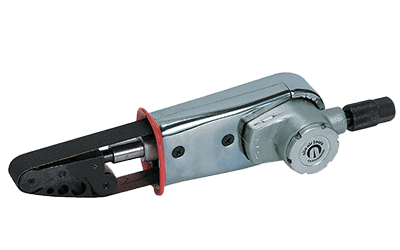What Is a Belt Sander?

A Belt Sander is a power tool that grinds objects by rotating a sanding belt between two rollers at high speed.
It is suited for work that requires strong sanding power, such as rust removal, paint removal, and rough scraping of wood, metal, and other surfaces.
There is a flat metal base on the bottom, and a belt moves across the surface. By pressing the belt against the object, the object is sanded.
Uses of Belt Sanders
Belt Sanders are used in DIY and other applications to process a variety of materials. Specifically, they are used for chamfering and polishing wood, smoothing surfaces, shaving corners, deburring metal, and polishing surfaces.
Due to its high abrasive power, it is not suitable for finish sanding. The key to a good final product is to use a belt sander for materials with poor surface conditions, sand rough surfaces, and then use a random or orbital sander for finish sanding.
In addition to DIY, belt sanders are also used by carpenters, metalworkers, and auto body shops.
Principle of Belt Sanders
The principle of belt sanders is that a sanding belt rotating at high speed is applied to the surface of the object to be sanded by scraping the surface of the object. The amount of sanding and surface roughness can be adjusted according to the coarseness of the belt.
Types of Belt Sanders
There are four types of belt sander to choose from The type used by holding the main unit includes the up-handle type, the square type, and the narrow type with a thin belt, which grinds by pushing the operating belt against a fixed object.
There is also the stationary type, in which the main body of the belt sander is fixed and the object is ground by placing it against the rotating belt.
1. Up-Handle Type
This type of sander is specialized for hand-held work. The up-handle type can be used to efficiently polish furniture tops and large floor surfaces.
2. Square Type
It is used by holding the main body by hand and features grips on the front and back of the main body. Thereby, the square type can be used like a stationary type with the sanding belt on the top surface. It can efficiently sand and finish small materials.
3. Narrow Type
The narrow belt is characterized by its narrow width. The narrow type is suitable for sanding narrow and complex-shaped objects.
4.Stationary Type
Compared to other types, the main body of this type is larger, which allows for a wider polishing range. By manually placing the object against the rotating belt, detailed forming processes such as corner removal can be performed efficiently.
How to Select a Belt Sander
The following points should be considered when selecting a belt sander:
1. Power Consumption
The appropriate motor power depends on the object to be sanded. A belt sander with a higher power consumption (W) is a more powerful motor. If you are sanding a large area or a hard material, you should select a belt sander with a higher power consumption.
2. Belt Width and Length
Belt width and length should be selected according to the size of the material to be sanded. For small materials, a narrower width is acceptable, but when sanding large materials, a wider width and longer length will improve work efficiency.
The most common belt widths are 76 mm or 100 mm. Narrower models have a belt width of 30 mm or less.
3. Other
Some belt sanders may have various functions such as adjustable sanding speed, dust suction function, dustproof performance, and so on.
It is better to select the function that suits your work. For woodworking, a dust collection function improves work efficiency because it reduces the need for cleaning after use.
Other Information on Belt Sanders
How to Use a Belt Sander
The following is an explanation of how to use an up-handle type or other type of belt sander that is used for sanding by holding the belt sander itself.
- Turn on the power while the belt is separated from the object, and rotate the belt until it stabilizes.
- When the belt slowly makes contact with the object, the belt will sand the object.
- The weight of the main unit itself is sufficient to grind the object, so pressing force is not necessary.
- The rotation of the belt applies a forward force to the main unit, so the hand holding the unit should be lightly applied in the opposite direction.
The speed of belt sanders is adjustable. Rough grinding and paint peeling are performed at high speed, and when surface finish is important, sanding is performed at low speed. Sanding belts are selected based on the surface roughness after sanding and the size of the body.
The larger the belt number, the finer the surface finish. Belt sizes for general processing are as follows:
- #60: Roughing of wood, peeling of paint
- #80 and up: Polishing of non-metals
- #150 and up: Finishing wood